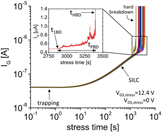Crossref Citations
This article has been cited by the following publications. This list is generated based on data provided by
Crossref.
Kysylychyn, Dmytro
Suffczyński, Jan
Woźniak, Tomasz
Gonzalez Szwacki, Nevill
and
Bonanni, Alberta
2018.
Resonant excitation of infrared emission in GaN:(Mn,Mg).
Physical Review B,
Vol. 97,
Issue. 24,
Liu, Jin-Long
Chen, Liang-Xian
Wei, Jun-Jun
Hei, Li-Fu
Zhang, Xu
and
Li, Cheng-Ming
2018.
Surface Carbonization of GaN and the Related Structure Evolution during the Annealing Process.
Chinese Physics Letters,
Vol. 35,
Issue. 1,
p.
016101.
Naidu, Tineesha
Muhamad Hatta, Sharifah Wan
Soin, Norhayati
Rahman, Sharidya
and
Wahab, Yasmin Abdul
2018.
study on breakdown characteristics of A1GaN/GaN-based HFETs.
p.
41.
Keum, Dongmin
and
Kim, Hyungtak
2019.
Proton Irradiation Effects on the Time-Dependent Dielectric Breakdown Characteristics of Normally-Off AlGaN/GaN Gate-Recessed Metal-Insulator-Semiconductor Heterostructure Field Effect Transistors.
Micromachines,
Vol. 10,
Issue. 11,
p.
723.
Islam, Abdullah Al
Hasan, Md. Soyaeb
Islam, Md. Rafiqul
Kaysir, Md. Rejvi
and
Mehedi, Ibrahim Mustafa
2019.
Study of Ohmic Contact on p-InGaN Using MIGS Model.
p.
1.
del Alamo, Jesus A.
and
Lee, Ethan S.
2019.
Stability and Reliability of Lateral GaN Power Field-Effect Transistors.
IEEE Transactions on Electron Devices,
Vol. 66,
Issue. 11,
p.
4578.
Heuken, Lars
Ottaviani, Alessandro
Fahle, Dirk
Zweipfennig, Thorsten
Lükens, Gerrit
Kalisch, Holger
Vescan, Andrei
Heuken, Michael
and
Burghartz, Joachim N.
2020.
Limitations for Reliable Operation at Elevated Temperatures of Al2O3/AlGaN/GaN Metal–Insulator–Semiconductor High‐Electron‐Mobility Transistors Grown by Metal‐Organic Chemical Vapor Deposition on Silicon Substrate.
physica status solidi (a),
Vol. 217,
Issue. 7,
Que, Tao-Tao
Zhao, Ya-Wen
Qiu, Qiu-Ling
Li, Liu-An
He, Liang
Zhang, Jin-Wei
Feng, Chen-Liang
Liu, Zhen-Xing
Wu, Qian-Shu
Chen, Jia
Li, Cheng-Lang
Zhang, Qi
Rao, Yun-Liang
He, Zhi-Yuan
and
Liu, Yang
2020.
Evaluation of stress voltage on off-state time-dependent breakdown for GaN MIS-HEMT with SiNx gate dielectric*.
Chinese Physics B,
Vol. 29,
Issue. 10,
p.
107201.
Viey, A. G.
Vandendaele, W.
Jaud, M.-A.
Gerrer, L.
Garros, X.
Cluzel, J.
Martin, S.
Krakovinsky, A.
Biscarrat, J.
Gwoziecki, R.
Plissonnier, M.
Gaillard, F.
Modica, R.
Iucolano, F.
Meneghini, M.
Meneghesso, G.
and
Ghibaudo, G.
2021.
Influence of Carbon on pBTI Degradation in GaN-on-Si E-Mode MOSc-HEMT.
IEEE Transactions on Electron Devices,
Vol. 68,
Issue. 4,
p.
2017.
Li, Feiyu
Wang, R.
Huang, Huolin
Ren, Y.
Liang, Z.
Ren, G.
Tao, Pengcheng
Sun, Zhonghao
Sun, Nan
Zhao, Cheng
and
Liang, H.
2021.
Temperature-Dependent Hot Electron Effects and Degradation Mechanisms in 650-V GaN-Based MIS-HEMT Power Devices Under Hard Switching Operations.
IEEE Journal of Emerging and Selected Topics in Power Electronics,
Vol. 9,
Issue. 5,
p.
6424.
Dutta Gupta, Sayak
Joshi, Vipin
Roy Chaudhuri, Rajarshi
and
Shrivastava, Mayank
2021.
Observations regarding deep-level states causing p-type doping in AlTiO gate and positive threshold voltage shift in AlGaN/GaN high electron mobility transistors.
Journal of Applied Physics,
Vol. 130,
Issue. 1,
Viey, A.G.
Vandendaele, W.
Jaud, M.-A.
Coignus, J.
Cluzel, J.
Krakovinsky, A.
Martin, S.
Biscarrat, J.
Gwoziecki, R.
Sousa, V.
Gaillard, F.
Modica, R.
Iucolano, F.
Meneghini, M.
Meneghesso, G.
and
Ghibaudo, G.
2021.
Study on the difference between ID(VG) and C(VG) pBTI shifts in GaN-on-Si E-mode MOSc-HEMT.
p.
1.
Morita, Masaya
Ishibashi, Keiji
Takahashi, Kenichiro
Ueda, Shigenori
Chen, Jun
Tatejima, Kota
Chikyow, Toyohiro
Ogura, Atsushi
and
Nagata, Takahiro
2022.
Effect of reactive gas condition on nonpolar AlN film growth on MnS/Si (100) by reactive DC sputtering.
Japanese Journal of Applied Physics,
Vol. 61,
Issue. SC,
p.
SC1071.
Kortge, David
Maize, Kerry
Lyu, Xiao
Bermel, Peter
Ye, Peide
and
Shakouri, Ali
2023.
Concurrent characterization of GaN MOSHEMT gate leakage via electrical and thermoreflectance measurements.
Microelectronics Reliability,
Vol. 148,
Issue. ,
p.
115122.
Liu, An-Chen
Tu, Po-Tsung
Chen, Hsin-Chu
Lai, Yung-Yu
Yeh, Po-Chun
and
Kuo, Hao-Chung
2023.
Improving Performance and Breakdown Voltage in Normally-Off GaN Recessed Gate MIS-HEMTs Using Atomic Layer Etching and Gate Field Plate for High-Power Device Applications.
Micromachines,
Vol. 14,
Issue. 8,
p.
1582.
Chen, Yi-Ho
Chu, Fu-Chuan
Uma, M.
Aslam, Muhammad
Lee, Yao-Jen
Li, Yiming
Samukawa, Seiji
and
Wang, Yeong-Her
2024.
Threshold Voltage Stability in AlGaN/GaN MIS-HEMT Structure Under Cryogenic Environment.
IEEE Transactions on Electron Devices,
Vol. 71,
Issue. 11,
p.
6566.
Garg, Tanvika
and
Kale, Sumit
2024.
Recent Developments, Reliability Issues, Challenges and Applications of GaN HEMT Technology.
IEEE Electron Devices Reviews,
Vol. 1,
Issue. ,
p.
16.
Gill, Lee
DasGupta, Sandeepan
Neely, Jason C.
Kaplar, Robert J.
and
Michaels, Alan J.
2024.
A Review of GaN HEMT Dynamic ON-Resistance and Dynamic Stress Effects on Field Distribution.
IEEE Transactions on Power Electronics,
Vol. 39,
Issue. 1,
p.
517.
Sun, Nan
Dai, Jianxun
Huang, Huolin
Zhang, Jiayu
Lei, Yun
Wang, Ronghua
Tao, Pengcheng
Liu, Yanhong
Song, Shukuan
Ren, Yongshuo
Cheng, Wanxi
and
Liang, Huinan
2025.
Improved breakdown voltage and dynamic Ron characteristics in normally-off GaN-based HEMTs featuring fully-recessed and bilayer-dielectric gate structure.
Journal of Physics D: Applied Physics,
Vol. 58,
Issue. 4,
p.
045106.



